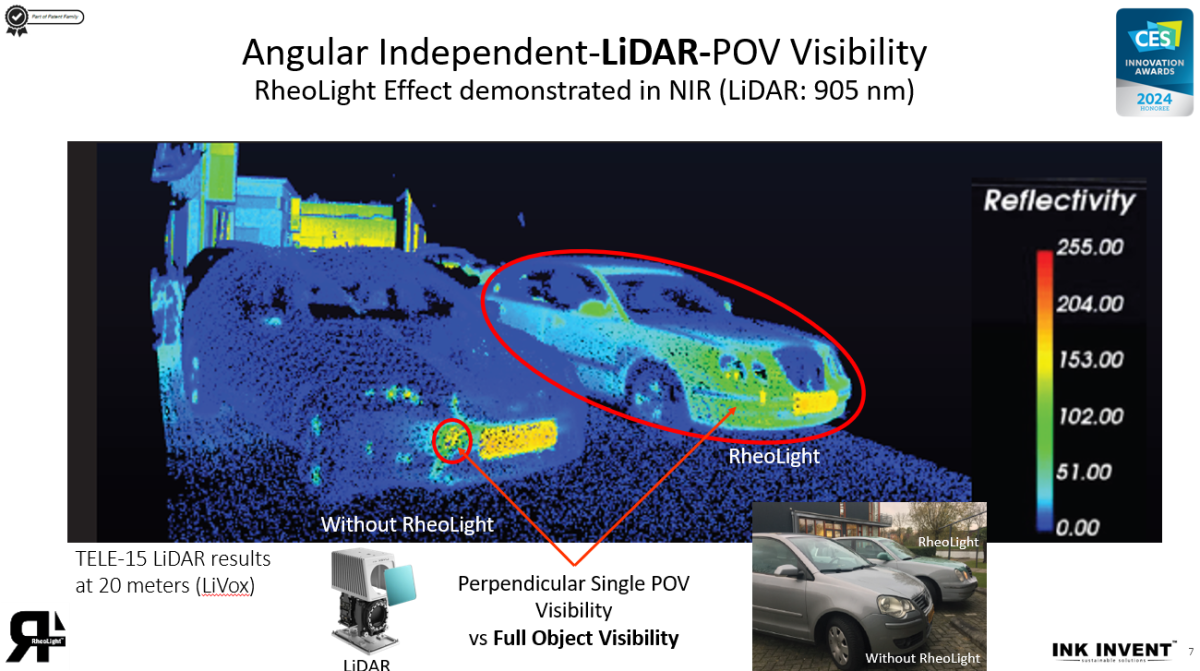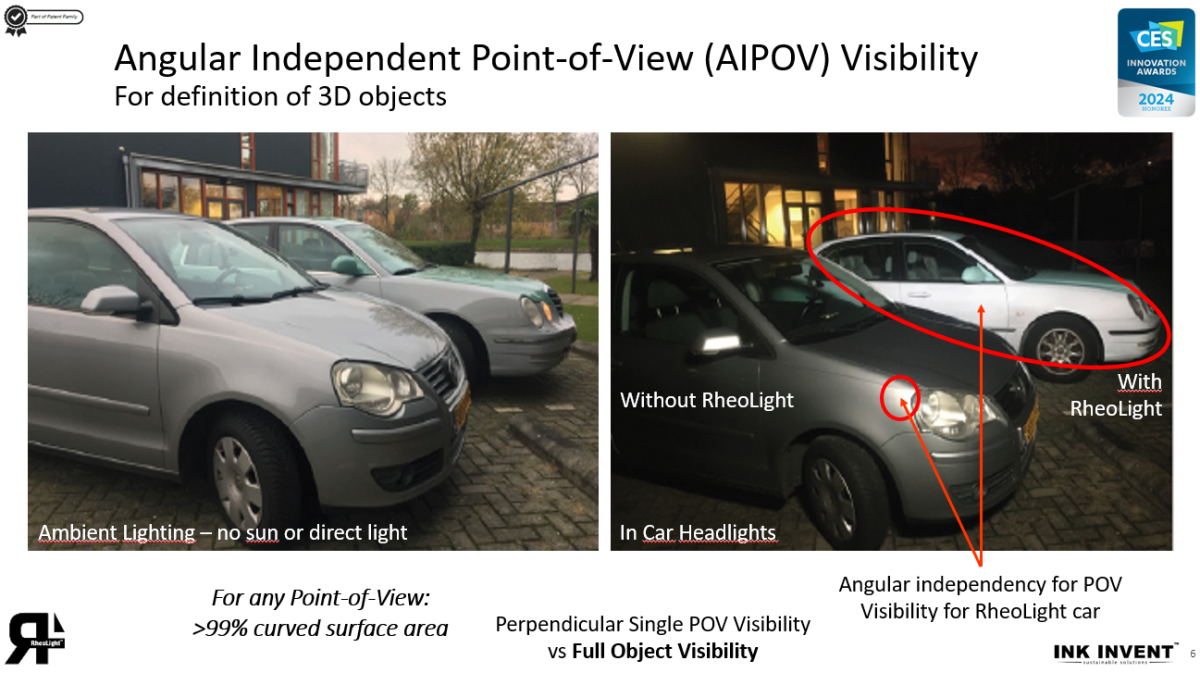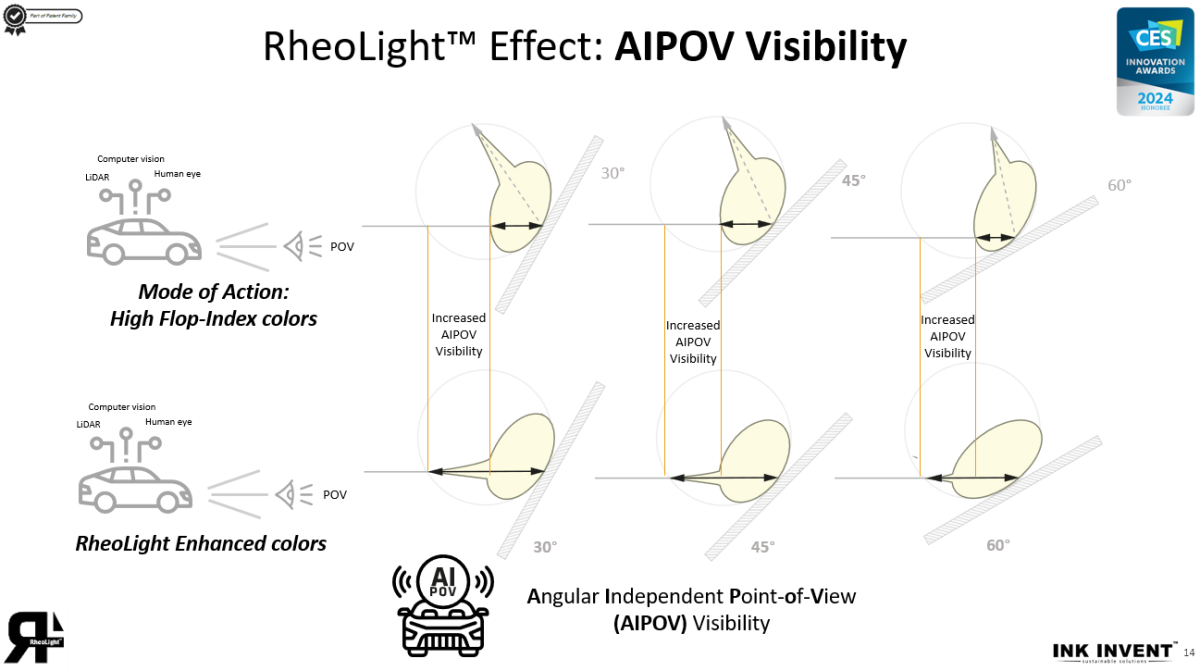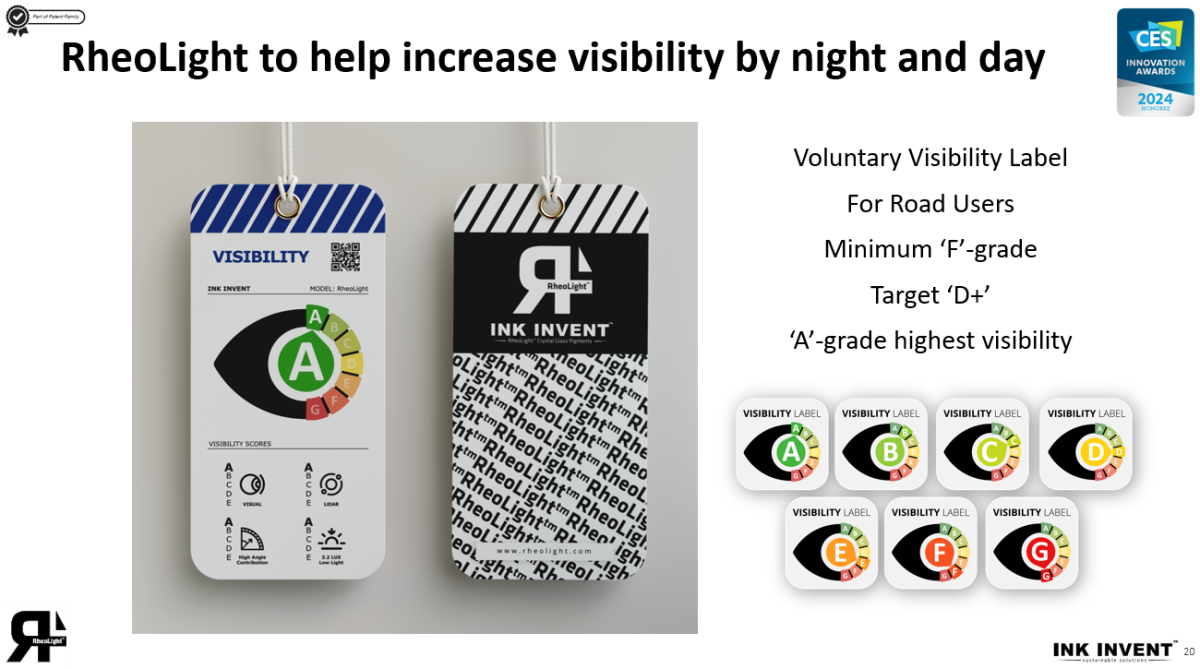Initiative details
We are solving the two main unsettled topics in Camera and LiDAR Systems and human vision in traffic situations. The internally developed Visibility Label, featuring a new universally applicable reference color, addresses the first topic, which is the lack of a universal method for quantifying the visibility of complex shapes such as cars, bikes, and busses. Crystal Glass Pigments provide a solution for the second unresolved issue, focusing on improving the functionality (i.e. visibility) of coatings on vehicles. By formulating new colors with this innovative additive, the coatings become significantly better visible for camera systems, human vision at night, and LiDAR systems 24/7.
Initiative date
Who was/is your target audience?
Policy makers
Public authorities
Topic
Create awareness
Improve vehicles and infrastructure
Knowledge building and sharing
Provide alternative solutions
Organisation details
Ink Invent BV
Enterprise
Netherlands
Nieuwegein
Contact name
Paul Mijnen
Telephone number
+31638632163
p.mijnen@inkinvent.com
Website link
Project activities
If you work together with external partners, list the most important partners and briefly describe their role.
We are first working to establish a baseline in awareness and measurement of the visibility of existing colors. Working with existing color characterization companies, we are defining and standardizing a new visibility method to create an industry-wide accepted safety benefit model. We will collaborate with industry-specific standard and guideline committees to enhance and accelerate market acceptance even further.
Please describe the project activities you carried/are carrying out and the time period over which these were implemented.
The creation of RheoLight Crystal Glass Pigments has been the result of six years of research and in-market testing. Market feedback has contributed to numerous important improvements, allowing us to apply the product in a commercially viable and industrially applicable way. This will benefit the broader mobility sector and significantly improve road safety by enhancing the understanding of the traffic environment and increasing the visibility of individual traffic participants.
The value proposition of our research and development is centered around the quantifiable improvement of visibility for complex shapes in the mobility sector. Over the past 1.5 years, extensive R&D has culminated in the creation of a Visibility Method. This method aims to provide a quantifiable and comparable parameter to describe the visibility of complex shapes in the mobility sector, such as cars, bikes, and buses. The Visibility Label is based on the new tuneable color-concept of AIPOV (Angular Independent Point-of-View) Visibility.
The value proposition of our research and development is centered around the quantifiable improvement of visibility for complex shapes in the mobility sector. Over the past 1.5 years, extensive R&D has culminated in the creation of a Visibility Method. This method aims to provide a quantifiable and comparable parameter to describe the visibility of complex shapes in the mobility sector, such as cars, bikes, and buses. The Visibility Label is based on the new tuneable color-concept of AIPOV (Angular Independent Point-of-View) Visibility.
In terms of implementation, what worked well and what challenges did you need to overcome?
Market feedback has been essential in forging a path to a successful implementation of a viable and practical application of the innovative functional pigments: Crystal Glass Pigments. The main challenge remains the perceived newness of these effect pigments throughout the entire supply and value chain, from paint manufacturers to car painters to OEM brands to the final customer. Promoting awareness of the measurable visibility of colored cars, bikes and busses, through the whole supply chain, will be accelerated by also creating awareness in the eco-system of color-measurment and safety-oriented organizations, such as insurance companies and regulatory bodies. This takes time and an integral approach to road safety.
Evaluation
Please summarise how you have evaluated the initiative’s impact (e.g. social media reach, survey, feedback forms, statistics).
Ink Invent is currently in the process of evaluating the safety impact of Crystal Glass Pigments and a new visibility model. The introduction of the visibility model to any user group increases the need to measure visibility for color styles used by both OEMs and paint manufacturers. First brands are already introducing their products, such as bikes, with a Visibility Label. The label follows an EU-style rating system with levels from G through A. Evaluation of the visibility initiative is being further elaborated through the creation of a separate independent entity focused on measuring and determining the Visibility Label of a mobility color. Visibilitysaveslives.org exemplifies and brings this new approach to visibility to life. Plans are being developed to use this method to refine existing or define new measurement systems and norms by adding to existing standards and working with regulatory and standardization committees and organizations to further road safety.
What has been the effect of the activities?
The first effects of introducing both a visibility label and a functionality enhancing pigment demonstrate the realization that an unknown solution has emerged for a formerly accepted unchangeable challenge. The supply and value chain are demonstrating interest and increased awareness by asking for three-dimensional visibility labels for their existing colors and new color stylings. The value chain is even positively taken by surprise after introduction of an already relatively mature Visibility Label. The supply and value chains are now able to communicate about the safety of color and have an independent reference model for further color development.
Please briefly explain why your initiative is a good example of improving road safety.
Solving the crucial issue of quantifying visibility in road safety and influencing this factor, while also raising awareness of the three-dimensional visibility of vehicle colors, will improve current road safety and pave the way for future enhancements. Autonomous driving is on the horizon, and the levels of autonomy and the maturity of ADAS systems can improve with more and better data, which can be transformed into improved information. This supports faster and better decision-making, leading to a safer traffic environment and improved road safety.
How have you shared information about your project and its results?
After developing both the Crystal Glass Pigment class and the Visibility Label, we have introduced the first product and visibility quantification versions worldwide to the value chain of automotive and mobility manufacturers and brands. The visibility product and model have been further improved based on market feedback. We have recently launched www.visibilitysaveslives.org to raise awareness and educate those interested. The site includes a call to action to get involved with the road safety visibility campaign.





